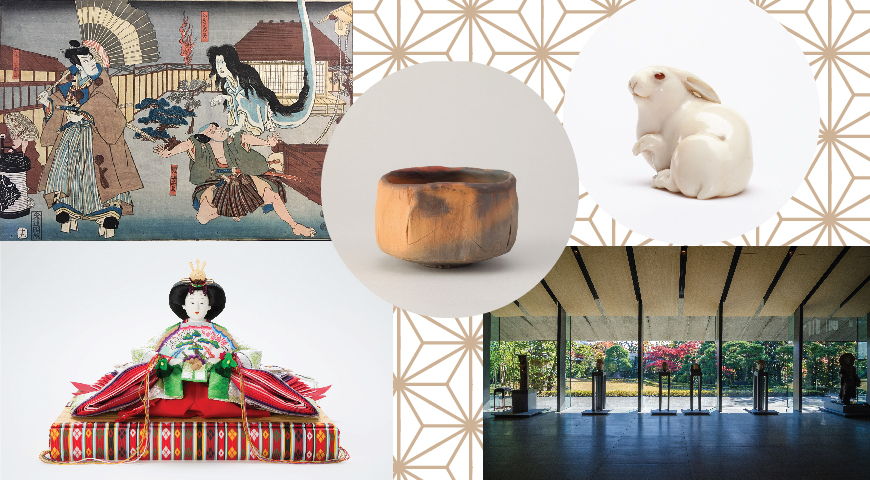

In conjunction with Japan Foundation's Doors to Arts of Japan video series, Japanese art historian Meher McArthur introduces the fascinating Japanese culture. This lecture series was conducted virtually from November 21, 2023 to March 21, 2024.
To the Japanese, yokai are mysterious phenomena and weird creatures that have inhabited the country’s landscape, homes, folklore and imagination for many centuries. They can be evil or benign spirits, ranging from shape-shifting animals like foxes and badgers, who adopt human form to trick, bewitch or reward humans, to the vengeful ghosts of warriors killed in battle or women wronged by their husbands. Yōkai can also be supernatural creatures from folklore like kappa (river imps that pull people and horses into the water), oni (demons that cause devastation, storms and plagues), and even objects like umbrellas and lanterns that mysteriously come to life. CLICK HERE!
Netsuke are small toggles that are attached to the end of the cords used to hang various accessories – like tobacco pouches, writing sets and medicine containers – from the kimono sash, or obi. The cord is passed underneath the obi and the netsuke hangs over the top of the sash, securing the accessory in place. Netsuke are made of a variety of materials and are often masterpieces of sculpture, often carved into animals, insects, comical human figures and even lucky gods. CLICK HERE!
Japan’s dolls are famous throughout the world as elegant works of art that are more for display than play. Hina dolls, in particular, wear kimono and elaborate hairstyles, and for several centuries have been central in Hina Matsuri, a traditional festival celebrating girls. Others, such as turned-wood Kokeshi, finely sculpted Saga dolls, papier mache Hariko dolls, and folded paper Chiyogami dolls have been crafted and treasured in different regions of Japan for many generations. CLICK HERE!
The term “yakishime” refers to the firing of unglazed clay vessels at a high temperature so that the clay vitrifies, creating water-proof and durable stoneware ceramics. With no colorful glaze or painted designs, this ceramic type may seem simple or “primitive,” but Japan’s yakishime wares are some of the country’s most admired and valuable ceramics. The scorch marks of Bizen ware, the feldspar speckles of Shigaraki ware, and the warm, earthy tones of Tokoname ware have made these wares beloved in the tea ceremony and collected widely for centuries. CLICK HERE!
For lovers of Japan’s various artistic traditions, there are many different museums all over Japan. Some are public institutions, while others house the collections of private collectors. Some are encyclopedic in their holdings, while others are devoted to a particular type of art or to a specific artist. Many are works of art in their own right, built by some of the world’s foremost architects. CLICK HERE!
 Meher McArthur
Meher McArthur
Meher McArthur is an Asian art historian specializing in Japanese art, with degrees from Cambridge University and London University’s School of Oriental and African Studies (SOAS). She was Curator of East Asian Art at Pacific Asia Museum, Pasadena, CA (1998-2006) and for over a decade has curated traveling exhibitions for International Arts & Artists (IA&A), most recently Washi Transformed: New Expressions in Japanese Paper (2021-2024) on view at the Mingei International Museum in San Diego until January 7, 2024. Her most recent exhibition SHIKI: The Four Seasons in Japanese Art opened at the Sturt Haaga Gallery at Descanso Gardens in February 2023. She was Creative Director for the Storrier Stearns Japanese Garden, Pasadena (2014-2020), Academic Curator for Scripps College, Claremont (2018-2020) and Art and Cultural Director for JAPAN HOUSE Los Angeles (2020-2022). Her major publications include Gods and Goblins: Folk Paintings from Otsu (PAM, 1999), Reading Buddhist Art (Thames & Hudson, 2002) and The Arts of Asia (Thames & Hudson, 2005), Confucius (Pegasus Books, 2011), Folding Paper: The Infinite Possibilities of Origami (IA&A, 2012), New Expressions in Origami Art (Tuttle, 2017), Washi Transformed: New Expressions in Japanese Paper (IA&A, 2021) and An ABC of What Art Can Be (The Getty Museum, 2010).
